Kit Bakke's Blog, page 3
July 18, 2020
One COVID-19 (True) Story
July 17, 2020
The port-a-potty stands directly outside our living room window, on the parking strip of our across-the-street neighbors. They are having their house painted, so the port-a-potty is for the house painters, who happen not to be working today. Crossing my living room intent on one errand or another, I look out the window and see two people at the port-a-potty. At first, I am pleased to see it being used by this older couple who seem to be out on a walk on our leafy residential street. I do not recognize them, but with COVID-19, many people have come out of their houses to take walks that I have not seen before. It is good to see older people getting some outdoor exercise in these strange times. I think of Paris and other European cities which have provided public urinals to pedestrians in their downtown areas. So civilized.
I watch the couple across the street for a minute or two and realize that the woman is having trouble negotiating the six inch step between the inside of the port-a-potty where she is standing and the curbside concrete. She tentatively puts a slip-on sneakered foot down, hovering it in the air for a few seconds and then suddenly drawing it back to the port-a-potty floor. She looks like she is testing the air and doesn’t like what she feels. Her husband is standing on the concrete, his back holding the port-a-potty door open, cradling her left arm and gently coaxing her to try again. She does, and fails again.
The man appears to be in his late 60s, maybe older. He is wearing baggy pants and a wrinkled button down shirt not well tucked-in over his paunchy middle. He has wispy white hair and glasses. No mask or gloves. The woman is probably about the same age, but has dark red hair, straight, shoulder-length and uncombed. She is wearing a man’s plaid shirt and pants. No mask or gloves. Neither look particularly healthy.
I watch them repeat her attempts to leave the port-a-potty several more times. My first thought, once I realize her predicament, is that if there were another person to stabilize her on her right side, that she could probably make it down the six inches. I start to walk over to my front door to go help them.
But I stop.
I am almost 74 years old, a prime target for COVID-19. I have no other risk factors for it other than age, but I read the epidemiology statistics (I have a master’s degree in public health) and this couple across the street could easily be teeming with the virus. Their lack of masks indicates a lack of any serious understanding of its infectious nature and lethal impact.
So I watch them try and fail again. I feel like a terrible human being.
My husband suggests I call 911. They can help these people safely. Clearly the woman is in some distress and maybe she needs to be evaluated in other ways, once she’s rescued from the port-a-potty. I call 911. The woman on the line has difficulty seeing this as an emergency. She finally transfers me to the medical side and I talk to the medics at the fire department. They agree to come.
I go outside to our front steps to tell the man that the medics are coming. I chat with him while we wait. He sounds perfectly reasonable. They are visiting from out of town, he tells me, and his wife is having one of her panic attacks, that’s all. He asks me how to get back on the freeway. Surprised, I ask if they have a car. Of course they do he says. I have an image of dangerous driving and an accident.
After a few minutes of conversation, a young man in shorts, a tee shirt and a mask walks down the street. “Hi,” he says to the couple. “Looks like you could use a little help.”
In less than a minute he’s smoothly helped the wife leave the safety of the port-a-potty. As he says goodbye and resumes his own walk down the street, the fire truck arrives and two suited-up medics arrive. They are left with nothing to do but a little paperwork.
Nobody pays any attention to me, thank goodness. I feel terrible about being afraid to help and terrible about wasting the medics’ time.
This is a terrible virus, even if it doesn’t make you sick.
The post One COVID-19 (True) Story appeared first on Kit Bakke.
June 5, 2020
What to do now

Doesn’t need a caption…just some action
Here are some photos of flyers that I saw this morning on poles around our neighborhood–there was one other that didn’t photograph well, but was a great listing of black-owned businesses to support.
We do what we can and these are ideas for thing to do if you don’t want to mix it up on the streets, what with covid and tear gas and cops who’ve covered up their ID tags. Not a particularly safe scene, for sure.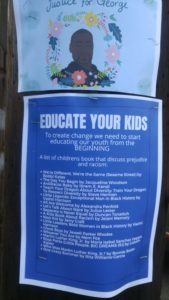
Let’s try to make some real progress against racism this time, so our grandkids don’t have to fight these battles all over again.
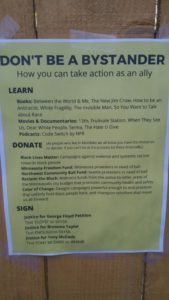
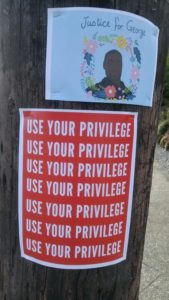
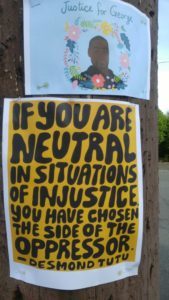
The post What to do now appeared first on Kit Bakke.
May 21, 2020
Animals happy about humans staying home

Barred owl seen on our afternoon walk a few blocks from our home in Seattle
Since people aren’t speeding their cars bumper to bumper on our streets, I’ve seen a much better use of the word bumper: we have a bumper crop of bunny rabbits and squirrels in our Seattle neighborhood. And songbirds! The mornings are a symphony.
On a walk a couple days ago, in the afternoon, we saw this lovely barred owl fly into this tree close to us and stare at us in that unsettling way that owls do. We were only a couple blocks from our house.
It was wonderful! Mother nature lives!
The post Animals happy about humans staying home appeared first on Kit Bakke.
May 14, 2020
Remember Pigpen?
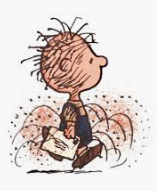
Remember Pigpen?
My brother recently sent an email to family showing how the corona virus surrounds us by sending along a picture of the Peanuts’ character Pigpen. An apt analogy, I think, and with the advantage of making the invisible visible.
Worth thinking about as we consider re-opening our stores and restaurants and planning large gatherings. What’s visible around Pigpen isn’t deadly, but what’s invisible around many of us is.
Stay safe by listening to the virologists and epidemiologists. They know whereof they speak.
The post Remember Pigpen? appeared first on Kit Bakke.
April 29, 2020
Barbara’s Garden
Tough times, all around. But it’s also spring. Here in Seattle, that means our back gardens are doing their best to cheer us up. But even that is a mixed blessing, when it’s my friend Barbara’s garden. Barbara BonJour died April 18 of cancer. She was my friend for almost 40 years. We traveled together, hiked together, cooked together, became friends with each other’s friends, talked, celebrated and cried together…
Barbara’s yoga teacher Fran Gallo took these photos of Barbara’s garden last week. There’s no better tribute. https://frangallo.com/everything-in-i...
Go to Fran’s blog and enjoy!
The post Barbara’s Garden appeared first on Kit Bakke.
April 9, 2020
Forgot three things
Three new things to add to the list of what to do whilst self-isolating:
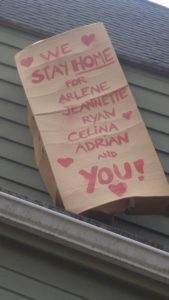
Fun to walk the deserted streets of our neighborhood and see friendly signs.
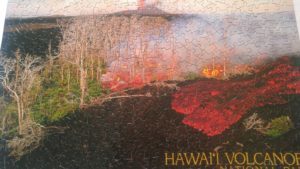
Do a jigsaw puzzle! I’ve never liked doing puzzles, but now I see how addictive they can be. This one was tricky. But sad to see the trees burning.
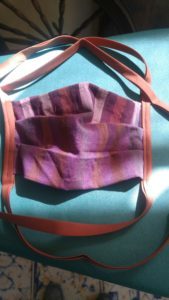
Make a mask. This is my first, a partially modified version of an online pattern from Kaiser Permanente.
The post Forgot three things appeared first on Kit Bakke.
March 31, 2020
Viral Blog
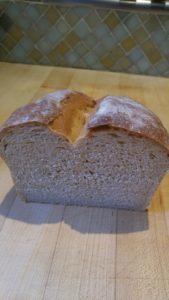
Bread during lockdown. I made it from a Paul Hollywood recipe. Quite yummy.
You’d think I had all the time in the world these days to write blog after blog, essay after essay for this website. Here I am, self-isolated and socially-distanced as strictly any old person ought to be. Seattle may no longer be the hottest spot for this virus to congregate, mutate and plan new attacks, but we’re still pretty darn warm. Our health department and all the busy virologists at the Fred Hutch and the UW Virology Department are telling us that we have about another month before the worst of it is over.
I’ve had “write a website entry” on my suddenly empty calendar for two weeks now. But nary a step have I taken in that direction. I’ve instead done exactly the same things as so many of my friends and relations are doing.
Here’s the list:
Figure out how to do online grocery shopping.
Clean out drawers and closets. Maybe even start to tackle the basement.
Bake!
Arrange and participate in skype video gatherings.
Take walks, being careful to cross the street or veer onto a parking strip to avoid other people.
Garden in the backyard.
Marvel at the quiet of hardly any traffic, on the roads and in the air.
Be alternately forgetful of what’s really happening and pushing down severe anxiety at what’s really happening.
Read the news or avoid the news.
Watch a lot of movies and old TV shows, either about pandemics or definitely not about pandemics.
Talk on the phone.
Chat with neighbors across streets and fences.
Read books, either about pandemics or definitely not about pandemics. Re-read old comforting books.
Think about people who endured years in prison without going crazy, like Nelson Mandela.
Think about your friends and family, and how much you love them, and how you want to stay in better touch with them all once this is all over.
What have I left out?
The post Viral Blog appeared first on Kit Bakke.
March 3, 2020
Antarctica

Brash ice off Antarctic Peninsula January 2020
Spent most of January in Antarctica. Wanted to go to a place that humans haven’t yet had the chance to destroy. It was spectacular. The ice, the rocks, the sky, the water and the wildlife drew me in like nothing else. Here’s some photos. I don’t have enough words.
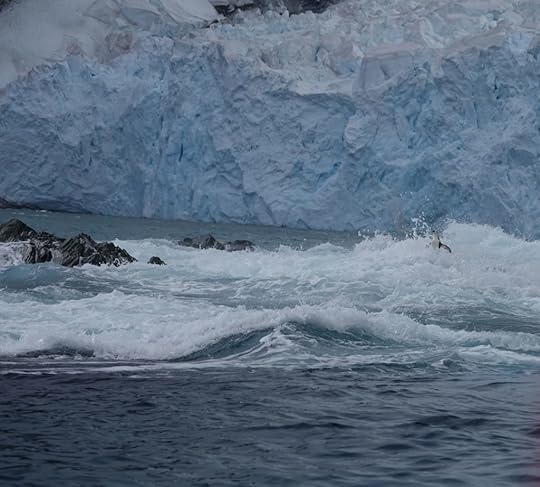
Chinstrap penguin being engulfed by waves near Elephant Island.
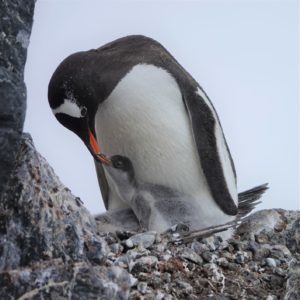
Gentoo penguin parent feeding baby.
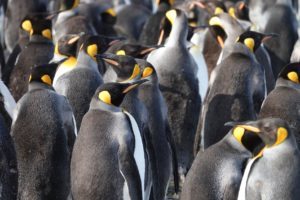
King penguins on South Georgia Island (where Shackleton is buried)
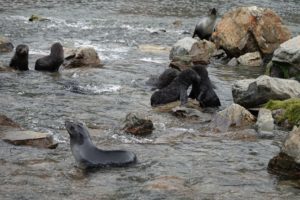
Fur seal pups on South Georgia island, near abandoned whaling station at Grytviken.
The post Antarctica appeared first on Kit Bakke.
February 6, 2020
Louisa’s take on Greta Gerwig’s Little Women
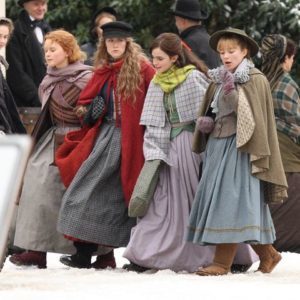
The 2019 Alcott sisters from Greta Gerwig’s film Little Women
Alcott on Gerwig’s Little Women
The author of Miss Alcott’s Email wonders what Louisa May would make of the new Oscar-nominated film adaption of her most beloved book.
By Kit Bakke
Director and screenwriter Greta Gerwig lets her audience know right away that her adaption of Little Women will be a little quirky: She begins her film with a quote from the real Louisa May Alcott: “I’ve had lots of troubles, so I write jolly tales.” It’s our first clue that we’ll see plenty of the beloved Jo March character, but we’ll also see snatches of the real Louisa—two sides of a similar, but not exactly the same, coin.
As one of Louisa’s many biographers—albeit a quirky one, as reviewers of my Miss Alcott’s Email have noted—I was curious to know what Alcott would have thought about Gerwig’s film version of Little Women. Here’s my take on Alcott’s reaction, if she were able to watch this wonderfully delightful and evocative film.
Although Louisa would likely find the modern-day scene cuts a bit too jumpy for her Victorian story-telling tastes, I’m sure she would have loved picking out the bits where actress Saoirse Ronan was playing Jo and where she was “being” Louisa. In the real life story of the Alcott family there was no rich, spoiled, handsome boy named Laurie living across the way; there was no Aunt March and therefore no big house and no happy school; and though Mr. March was indeed mostly absent, he never went to war (but Louisa did go as a Union Army nurse).
On the other hand, there was a musical Beth (her real name) and she did die, most likely of scarlet fever; Meg (Anna in real life) did marry and mother two children; Amy (May in real life) did go to Paris to study art, but didn’t give it up—she did well, and had a painting hung in the celebrated 1879 Paris Salon before she died in childbirth later that year; and, of course, in the end Louisa stayed true to her beliefs and did not marry anyone. Sadly, missing from all film versions of Little Women, and from Louisa’s own book, are the Alcott’s exceptional actual neighbors and friends: Henry David Thoreau, Ralph Waldo Emerson, and Nathaniel Hawthorne.
The parts of Louisa’s real life that sneak into this fictional film of a fictional story are telling and timely. For instance, when Marmee tell Jo that “I’m angry nearly every day of my life,” it rings totally true, as are all the lines sprinkled throughout about women’s lives, from Aunt March’s steely-eyed realism about women’s lack of occupational opportunities and the purpose of marriage, to all of Jo’s interactions with her condescending publishers. Louisa’s fierce loyalty and determination to earn enough to save her family from abject poverty is true and impossible to miss: Louisa hated being poor.
Louisa really did write in red hot streaks, as the Ronan’s Jo portrays. In particularly hot streak, working around the clock in the attic of the family’s Orchard House, Jo writes ambidextrously: when her right hand cramps up, she moves her pen to her left rather than stop writing. That was true.
Louisa left an unfinished story about two women named Diana and Persis. It was written for adults, not children. In the story she poses these four questions:
Can a productive and creative single woman be happy?
Can a married woman maintain her personal life and friends?
Can women be both personally happy and professionally successful?
Can people be happily married and still respect each other’s privacy and basic human rights?
These are all questions that were worth asking in Alcott’s day, and they’re questions still worth asking today—as Gerwig has, beautifully.
The post Louisa’s take on Greta Gerwig’s Little Women appeared first on Kit Bakke.
February 1, 2020
Been Traveling
Been traveling. South America is pretty much a mystery to me. We’ve traveled very little here, don’t speak Spanish, and are woefully ignorant about its land or its people. Although we have been to Machu Picchu and the surrounding Sacred Valley—all amazing, but another story—that’s just a tiny slice of our southern neighbors’ continent.
Peter and I spent New Year’s Eve 2019 on a Delta flight to Santiago, Chile where we spent four days on the way to Ushuaia to then jump off the continent to South Georgia Island and the Antarctic Peninsula. We stayed in a nice hotel in the old part of Santiago, across a leafy green park from the trickle of the slow, brown Mapocho river; also, we discovered, the center of the violent street protests that began in October are still ongoing. We watched young men gathering each evening around 7 pm in our neighborhood. Some wore bandannas over their faces, a few carried flags or signs, some rode scooters. All were there to face squads of Kevlar, gun and riot-outfitted soldiers and police, whose vehicles were ominous-looking khaki-painted, windowless vans, pock-marked from thrown rocks. Some were tank-like water cannons on wheels.

Water cannon on streets of Santiago
Each evening, both groups gathered at intersections and squares, attacking each other’s forward margins with the weapons they had at hand—shouts and rocks from the demonstrators, against the water cannons spraying high pressure water on groups of demonstrators and anyone else standing around. Also, if that didn’t work, tear gas.
This area of Santiago is graced with lovely old stone buildings, with curved carvings and elegant facades. Since spray painted slogans are one of the demonstrators’ methods of making their demands visible, these buildings and statues are now sadly defaced—I’m not sure they can ever be completely cleaned. On the other side, the broken promises and crumbling economy led by the current Chilean government is also not a pretty sight, and a good deal more damaging to human life than a graffiti’d building.

Graffiti on Santiago’s buildings
So far there have been 29 deaths and thousands of injuries since these protests began last fall. The initial spark was an increase in Santiago bus fares, which has blossomed into widespread anger over income inequality, government corruption, and rising costs of basic living expenses. The current president is named Pinera, and much of the graffiti notes his name’s similarity to Chile’s military dictator Pinochet, who overthrew (with the help of the United States CIA) the country’s elected president Allende in 1973.
Next stop: South Georgia Island and the Antarctic Peninsula.
The post Been Traveling appeared first on Kit Bakke.



